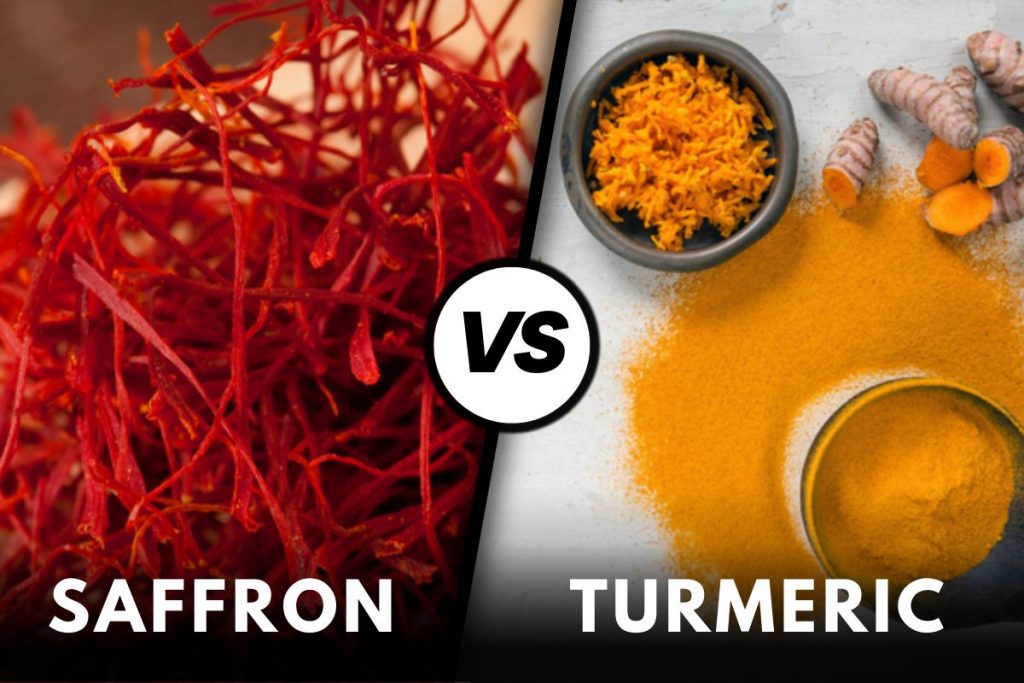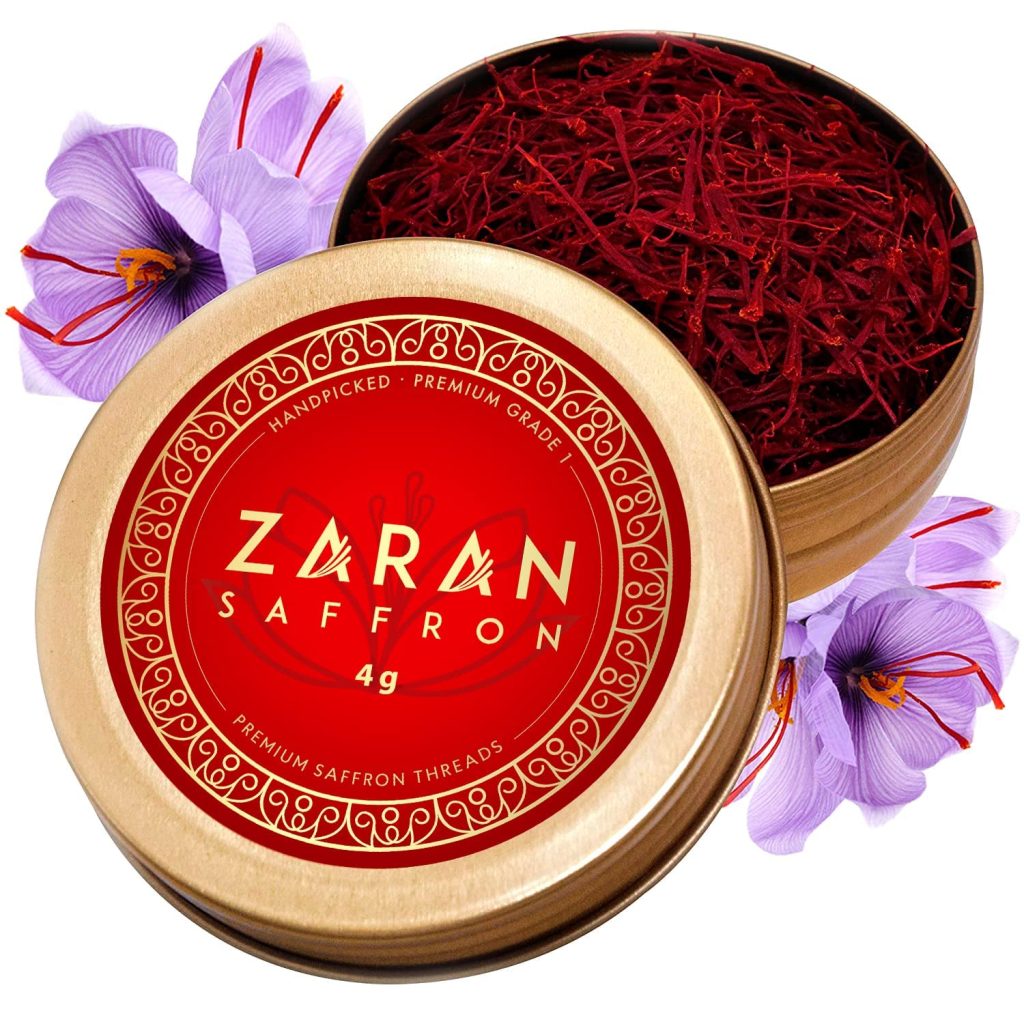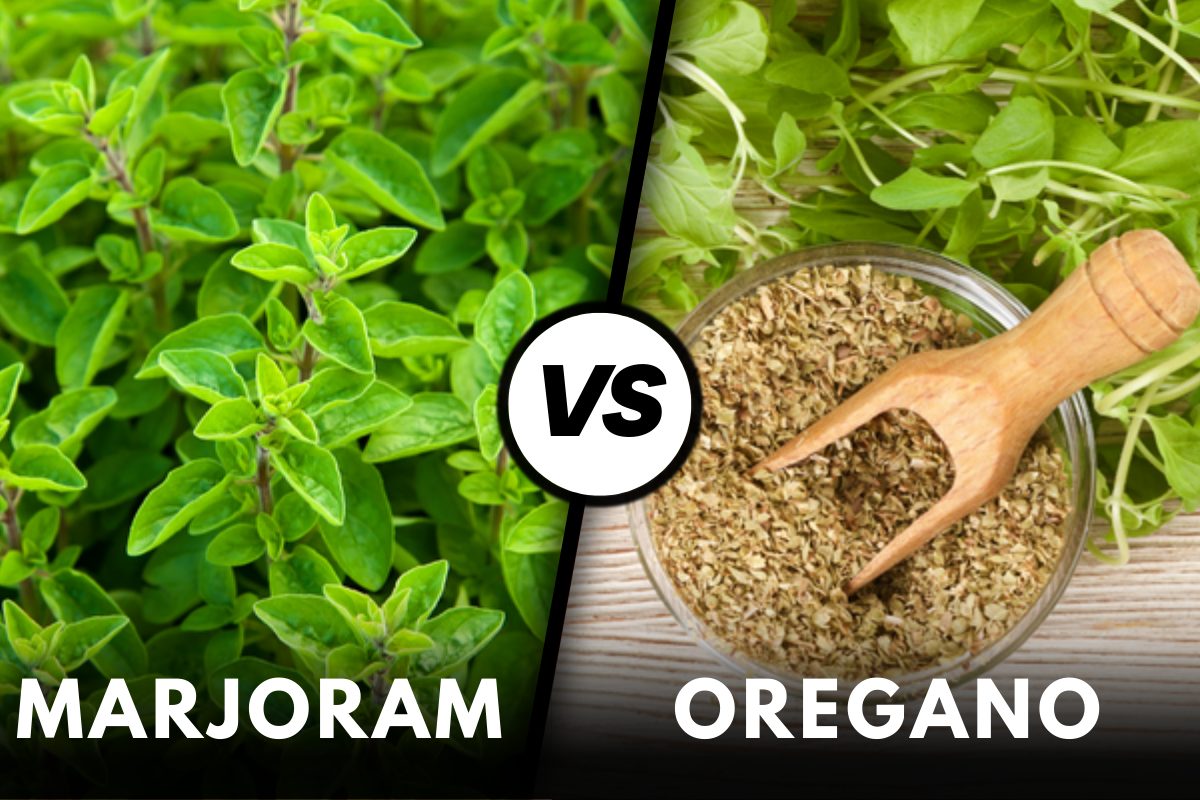When it comes to spices, there are many different options. Two popular choices are saffron and turmeric. While both spices can add flavor and color to food, they have some key differences. Here is a closer look at saffron vs turmeric:
- Saffron is more expensive than turmeric. This is because saffron is harder to grow and harvest.
- Turmeric has a stronger flavor than saffron. This means that you don’t need to use as much turmeric to get the desired flavor in your dish.
- Saffron provides a unique flavor that can be hard to replicate with other spices. On the other hand, turmeric can be replaced with other similar spices, such as curry powder or ginger.
- The color of turmeric is more intense than saffron. This is why turmeric is often used as a natural dye.
Remember these differences when choosing between saffron and turmeric for your next dish!

See Also: Cardamom vs Coriander
What Is Saffron?

The saffron crocus, or Crocus sativus, is a flower that produces the spice saffron. Saffron is used in many cuisines worldwide and has been used medicinally for centuries.
The active ingredient in saffron, crocin, has been shown to have antioxidant, anti-inflammatory, and anticarcinogenic properties.
Turmeric is a spice derived from the Curcuma longa plant. Turmeric has been used medicinally for centuries and is a common ingredient in Indian cuisine.
The active ingredient in turmeric, curcumin, has been shown to have antioxidant, anti-inflammatory, and anticarcinogenic properties.
What Is Turmeric?

An often-used spice in Indian cooking is turmeric, which has a yellow-pigmented color. It has a slightly bitter, earthy flavor and is often used as a colorant in food.
Turmeric is a ginger family member native to India and Southeast Asia. The spice is made from the Curcuma longa plant’s dried ground root. Turmeric has been used medicinally for centuries in traditional Chinese and Indian medicine.
The main ingredient in turmeric is curcumin, which has potent anti-inflammatory and antioxidant properties. Curcumin makes up only about 3% of turmeric by weight, but it is responsible for most of the health benefits associated with spice.
Turmeric treats various conditions, including arthritis, digestive disorders, skin conditions, and cancer. It can also boost cognitive function and help improve memory.
saffron vs. turmeric health benefits
Saffron and turmeric are both flavorful, healthful spices with a long history of use in traditional medicine. Though they share some similarities, they also have some essential differences. Here’s a look at the benefits of saffron and turmeric.
Saffron is a spice with a distinct, slightly bitter flavor that has been used in cooking for centuries. It’s also been used as a natural remedy for various ailments, including digestive problems, respiratory infections, and menstrual cramps. In addition, saffron is rich in antioxidants and has anti-inflammatory properties.
Turmeric is another spice with a long history of medicinal use. It’s best known for its bright yellow color, which comes from the chemical curcumin.
Turmeric has been shown to have powerful anti-inflammatory and antioxidant effects. It’s also been used to treat digestive problems, skin conditions, and pain.
Saffron and Turmeric Nutrition Facts
Saffron and turmeric are both healthy spices with a variety of nutrients. Here is a comparison of the two spices’ nutritional value per 100 grams (3.5 ounces).
Both saffron and turmeric contain high levels of vitamins and minerals, including iron, potassium, and magnesium. However, saffron has more vitamin C than turmeric, while turmeric has more calcium. Saffron also contains more protein than turmeric.
In terms of antioxidants, saffron contains more carotenoids than turmeric. Carotenoids are beneficial for eye health and can help to protect against certain cancers. Saffron also has a higher concentration of safranal, an antioxidant that gives the spice its characteristic flavor.
When it comes to health benefits, both saffron and turmeric be effective in treating a variety of conditions. Saffron helps treat depression, PMS, Alzheimer’s disease, and age-related macular degeneration. Turmeric helps treat arthritis, inflammatory bowel disease, and cancer.
Which Is Stronger Saffron or Turmeric?
Saffron has long been prized for its medicinal properties, and turmeric is a close second. But which one is stronger?
Saffron is often used as a natural treatment for depression, anxiety, and other mood disorders. It’s also been shown to be effective in treating certain types of cancer.
Turmeric, on the other hand, is commonly used to treat inflammation and pain. It’s also been shown to boost brain function and memory.
So, which one is stronger? It depends on what you’re looking for. If you’re looking for something to treat mood disorders or cancer, saffron is the better choice. Turmeric is the better choice if you’re looking for something to treat inflammation or pain.
Can You Substitute Turmeric for Saffron?
Turmeric and saffron are two very popular spices used in various cuisines. While they share some familiar flavor profiles, they are not interchangeable.
Saffron is much more expensive than turmeric and has a more delicate flavor that other ingredients can easily overpower. On the other hand, turmeric is a much cheaper alternative with a bolder flavor that can stand up to other intense flavors.
When deciding whether to use turmeric or saffron in a dish, you must consider the overall flavor profile you are trying to achieve.
Can You Take Saffron and Turmeric Together?
Yes, you can take saffron and turmeric together. Both spices have anti-inflammatory properties and can be beneficial for many health conditions. Saffron is also known for its mood-boosting effects, while turmeric is thought to aid in digestion.
Does Saffron Taste Like Turmeric?
Regarding culinary herbs, saffron and turmeric are often compared to one another. Both spices have strong, earthy flavors and can add color and flavor to dishes. But what does saffron taste like compared to turmeric?
Saffron has a more complex flavor than turmeric. It is often described as being slightly sweet with floral and hay-like notes. When used in cooking, saffron can add a unique depth of flavor to dishes.
On the other hand, turmeric has a simpler flavor that is often described as spicy and bitter. It is commonly used in Indian cuisine, which adds color and flavor to dishes. So, while saffron and turmeric both have intense flavors, they taste pretty different from one another.
If you’re looking for a spice with a more complex flavor, saffron is the way to go. However, turmeric may be a better option if you’re looking for something with a simpler flavor.
Conclusion
After reading this article, it’s clear that saffron and turmeric are very different spices. Saffron is more expensive and has a stronger flavor, while turmeric is less expensive and has a more mild flavor.
While they can be used interchangeably in some recipes, it’s essential to know the differences between these two spices before using them.
I am an accomplished tech writer with a passion for simplifying complex technology concepts. With a background in Tech, James has dedicated their career to making the intricacies of the digital world accessible to a broad audience.








